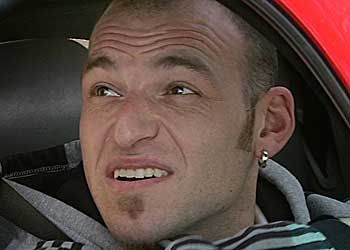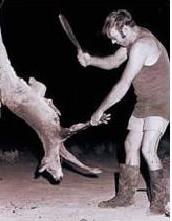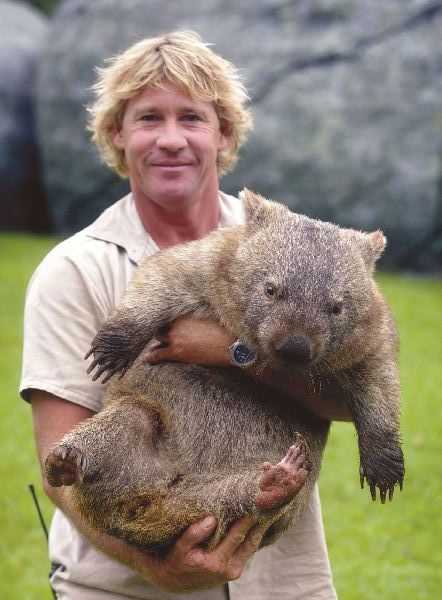Animal cruelty inculcates social deviance
Wednesday, June 20th, 2012 Australia’s Wildlife Hate
(Photo by Peter Culley taken on a backroad to Goolwa, Currency Creek, South Australia.)
Australia’s Wildlife Hate
(Photo by Peter Culley taken on a backroad to Goolwa, Currency Creek, South Australia.)
.
Peter’s comments:
‘An Australian icon…I was taken by the colours, textures and moronic behaviour of the idiot/s who did this in the first place…
For instance there was evidence they had initially fired the first shot at a further distance but not satisfied with that they moved closer… There was a very good chance they were peppered by numerous richochets… candidates for the Darwin Awards…It’s always the minority that ruin it for others…’
.
.
The following article was initially written by Tigerquoll entitled ‘Animal abuse inculcates social deviance‘ and published on CanDoBetter.net 20100403.Posted April 3rd, 2010 by Tigerquoll. Additional material has been added.
.
On 29-Mar-2010, Chris Palmer, the self-confessed serial roo shooter on CanDoBetter wrote:
“My son is an up and coming roo shooter to at the age of 4 he can skin and gut a roo nearly as quick as me and over the last 4 weekends he has shoot over 50 roos with only 8 misses they still didnt get away tho like always dad was there to clean up the mess.”
Clearly, this individual values his behaviour of slaughtering kangaroos acceptable to the extent he is inculcating in his young son his same values, attitudes and practices from an early age. Shooting wildlife is a violent crime against the natural animal kingdom. We are not savages anymore. We don’t have to kill wild animals. It is a choice and an immoral act. Clean kills are wrong but also occasional. The suffering death of a bullet injury by a 4 year old followed up with a knife or blunt axe to the joey reflects a vicious and depraved existence.
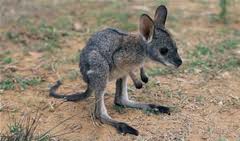 Orphaned kangaroo ‘joey’
Orphaned kangaroo ‘joey’
.
Cruelty Connections
.
‘According to a 1997 study done by the Massachusetts Society for the Prevention of Cruelty to Animals (SPCA) and Northeastern University, animal abusers are five times more likely to commit violent crimes against people and four times more likely to commit property crimes than are individuals without a history of animal abuse.
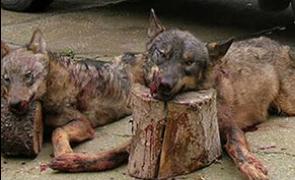 Gray Wolves (native to Alaska) killed under Sarah Palin’s predator control policy
[Source: ^http://www.grizzlybay.org/SarahPalinInfoPage.htm]
Gray Wolves (native to Alaska) killed under Sarah Palin’s predator control policy
[Source: ^http://www.grizzlybay.org/SarahPalinInfoPage.htm]
.
There’s something uniquely sickening about cases of animal abuse that outrages the community more than most crimes. To hear of a defenceless creature being brutalised by a cowardly attacker can get the blood of even the gentlest soul boiling.
 Serial killer Jeffrey Lionel Dahmer from Wisconsin (USA)
started on animals before moving on to humans.
Dahmer murdered 17 men and boys between 1978 and 1991. His murders involved rape, dismemberment, necrophilia and cannibalism.
In his childood he had put dogs heads on stakes.
(Photo: AP)
Serial killer Jeffrey Lionel Dahmer from Wisconsin (USA)
started on animals before moving on to humans.
Dahmer murdered 17 men and boys between 1978 and 1991. His murders involved rape, dismemberment, necrophilia and cannibalism.
In his childood he had put dogs heads on stakes.
(Photo: AP)
.
This week we learnt of the shocking case of Snowy, a much loved family pet suffering horrific injuries at the hands of a torturer. The 18-month-old cat’s ears were mutilated and he had been set alight. Also this week charges against the man believed to have tortured Buckley, a puppy who had his ears and tail hacked off, were dropped amid fears that the case would not stand up in court.
In recent months there have been multiple cases of animals being tortured and killed in a trend that appears to be Australia wide. It seems no animal is immune from such callous attacks; pets, wildlife, even dolphins have been targeted by individuals who derive some sort of thrill from inflicting pain on an innocent creature. Despite the increasingly violent and sadistic nature of these attacks and the public’s growing disgust, offenders if caught can expect little more than a slap on the wrist.
More often than not these cases don’t reach the courts but the few that do demonstrate our judicial system’s failure to treat animal abuse as a serious offence. Magistrates can impose jail terms of up to 5 years but it is extremely rare for a custodial sentence to be handed down in an animal abuse case. Despite extensive evidence linking cruelty to animals to serious violent offences against people, the judiciary continue to treat such crimes as largely trivial matters.
If our system is designed to punish as well as prevent serious criminal offences then surely greater attention needs to be paid to those who mistreat animals, particularly those who torture and kill for fun. The direct relationship between animal abuse and violent crime has been recognised by the FBI since the 1970s. Many of the world’s most notorious killers have long histories of animal abuse; Jeffrey Dahmer, Ted Bundy, David Berkowitz, Edmund Kemper and Albert DeSalvo better known as the Boston Strangler were all fond of torturing animals. In Australia murderers such as Paul Charles Denyer, Robert Barrett and Ivan Milat are known to have tortured animals long before they started killing people.
What greater motivation do our legislators and Courts need to treat animal cruelty with the utmost seriousness? Simply cautioning offenders is not good enough.
In the US, there has been a growing trend towards toughening laws to make animal abuse a felony rather than a misdemeanour. Penalties for individuals who engage in deliberate animal cruelty have been increased, dramatically in some states. England has similarly strengthened its animal welfare laws but in Australia we continue to treat these heinous crimes as minor offences not worthy of lengthy custodial sentences despite profilers and psychologists telling us that one of the strongest precursors to violent crime including murder is a history of animal abuse. Tough penalties including incarceration must be handed down for serious animal abuse cases.
You don’t need to be a psychologist to work out that only a uniquely depraved individual could ignore the agonised cries of a defenceless animal and continue the ghastly business of inflicting maximum pain and suffering.
To allow such cruel and sadistic behaviour to go unpunished is not only morally reprehensible, it may very well have dire consequences when at some point these offenders turn their particular brand of rage and fury on the rest of us.’
[Source: ‘Animal cruelty and the case for harsher punishment’, by Rita Panahi, 20050714, The Punch, ^http://www.thepunch.com.au/articles/animal-cruelty-and-the-case-for-harsher-punishment/] ..
‘Many studies in psychology, sociology, and criminology during the last twenty-five years have demonstrated that violent offenders frequently have childhood and adolescent histories of serious and repeated animal cruelty.‘
The FBI has recognized the connection since the 1970s, when its analysis of the lives of serial killers suggested that most had killed or tortured animals as children. Other research has shown consistent patterns of animal cruelty among perpetrators of more common forms of violence, including child abuse, spouse abuse, and elder abuse. In fact, the American Psychiatric Association considers animal cruelty one of the diagnostic criteria of conduct disorder.
The line separating an animal abuser from someone capable of committing human abuse is much finer than most people care to consider. People abuse animals for the same reasons they abuse people. Some of them will stop with animals, but enough have been proven to continue on to commit violent crimes to people that it’s worth paying attention to.
Virtually every serious violent offender has a history of animal abuse in their past, and since there’s no way to know which animal abuser is going to continue on to commit violent human crimes, they should ALL be taken that seriously. FBI Supervisory Special Agent Allen Brantley was quoted as saying
“Animal cruelty… is not a harmless venting of emotion in a healthy individual; this is a warning sign…” It should be looked at as exactly that. Its a clear indicator of psychological issues that can and often DO lead to more violent human crimes.
“So much of animal cruelty… is really about power or control,” Lockwood said. Often, aggression starts with a real or perceived injustice. The person feels powerless and develops a warped sense of self-respect. Eventually they feel strong only by being able to dominate a person or animal.
Sometimes, young children and those with developmental disabilities who harm animals don’t understand what they’re doing, Lockwood said. And animal hoarding – the practice of keeping dozens of animals in deplorable conditions – often is a symptom of a greater mental illness, such as obsessive-compulsive disorder.
Just as in situations of other types of abuse, a victim of abuse often becomes a perpetrator.
According to Lockwood, when women abuse animals, they “almost always have a history of victimization themselves. That’s where a lot of that rage comes from.”
In domestic violence situations, women are often afraid to leave the home out of fear the abuser will harm the family pet, which has lead to the creation of Animal Safehouse programs, which provide foster care for the pets of victims in domestic violence situations, empowering them to leave the abusive situation and get help.
.
“A significant amount of data, both anecdotal and empirical, show that animals are often killed or harmed to intimidate, frighten or control others including battered women or abused children.”
.
[Source: Arkow, 1996; Ascione,2001; Ascione & Arkow, 1999; Boat, 1995, ^http://www.thebegavalley.org.au/fileadmin/edentown/registrations/community/humane/old_hes/human_violence/].
Whether a teenager shoots a cat without provocation or an elderly woman is hoarding 200 cats in her home, “both are exhibiting mental health issues…but need very different kinds of attention,” Lockwood said.
Those who abuse animals for no obvious reason, Lockwood said, are “budding psychopaths.” They have no empathy and only see the world as what it’s going to do for them.
History is full of high-profile examples of this connection:
- Patrick Sherrill, who killed 14 coworkers at a post office and then shot himself, had a history of stealing local pets and allowing his own dog to attack and mutilate them.
- Earl Kenneth Shriner, who raped, stabbed, and mutilated a 7-year-old boy, had been widely known in his neighborhood as the man who put firecrackers in dogs? rectums and strung up cats.
- Brenda Spencer, who opened fire at a San Diego school, killing two children and injuring nine others, had repeatedly abused cats and dogs, often by setting their tails on fire.
- Albert DeSalvo, the “Boston Strangler” who killed 13 women, trapped dogs and cats in orange crates and shot arrows through the boxes in his youth.
- Carroll Edward Cole, executed for five of the 35 murders of which he was accused, said his first act of violence as a child was to strangle a puppy.
- In 1987, three Missouri high school students were charged with the beating death of a classmate. They had histories of repeated acts of animal mutilation starting several years earlier. One confessed that he had killed so many cats he’d lost count. Two brothers who murdered their parents had previously told classmates that they had decapitated a cat.
- Serial killer Jeffrey Dahmer had impaled dogs’ heads, frogs, and cats on sticks.
- More recently, high school killers such as 15-year-old Kip Kinkel in Springfield, Oregon, and Luke Woodham, 16, in Pearl, Missouri, tortured animals before embarking on shooting sprees. Columbine High School students Eric Harris and Dylan Klebold, who shot and killed 12 classmates before turning their guns on themselves, bragged about mutilating animals to their friends.
.
As powerful a statement as the high-profile examples above make, they don’t even begin to scratch the surface of the whole truth behind the abuse connection. Learning more about the animal cruelty/interpersonal violence connection is vital for community members and law enforcement alike.”
It is a fact that acts of animal cruelty lead to forms of cruelty against humans.
“A criminologist and forensic psychologist at Bond University, said the torturing, maiming and killing of animals were red flags of someone capable of future violence against people.”
They go on to state specific cases: “Archibald McCafferty, Sydney’s ‘Kill Seven’ murderer, used to strangle chickens, cats and dogs before killing people.”
“In Victoria, serial killer Paul Charles Denyer disembowelled a native cat and cut the throat of its kittens.” He went on to become the Frankston killer’ murdering Elizabeth Stevens, 18, Debbie Fream, 22, and Natalie Russell, 17, in Frankston Victoria in 1993.
[SOURCE: ^http://www.pet-abuse.com/pages/abuse_connection.php].
WARNING: THIS VIDEO CONTAINS DISTURBING ANIMAL CRUELTY WHICH MAY OFFEND. WE INCLUDE IT TO PORTRAY THE REALITY OF AUSTRALIA’S TREATMENT OF KANGAROOS
(To play video press the arrow in centre of video; to stop video press the pause button on bottom left)
.
2011: Hobart’s Jamie Peter Smart decapitates 3 kittens
.
‘A Hobart court has heard the DNA of a man accused of decapitating kittens was found on their bodies.
Jamie Peter Smart, 31, is appearing in the Hobart Magistrates Court, accused of decapitating two kittens and of strangling a third.
Prosecutor Mel Jerrim told the court Smart and two other men had gone to the Glenorchy home of the kittens’ owner in March last year because they thought she had thrown rocks to break up their all-night party.
The court was told the owner had refused to open the door and had called police when one of the men smashed the window of her car with a blockbuster. The first officer on the scene has given evidence of finding the body of one kitten, the head and body of another and just the body of a third.
The court heard a full DNA profile matching Smart’s was found on the decapitated kittens. DNA profiler Rita Westbury told the court it was unusual to get a full match from DNA transferred by contact. Normally such a match would come from a body fluid sample.
It suggested the kittens were handled for an extended period of time or with force.
Ms Westbury agreed it was not impossible that Smart’s DNA could have been transferred from blood on an axe handle to the kittens by a third person.
[Source: ‘DNA match on decapitated kittens, court hears’, 20111213, ^http://www.abc.net.au/news/2011-12-13/20111212-man27s-dna-found-on-decapitated-kittens2c-court-hears/3729272?section=tas] . .
.
Later in May 2012 Jamie Smart was found guilty…
‘A Glenorchy man has been found guilty on two counts of killing an animal. The three five-week-old kittens were found by police after being called by the kittens owner in March 2010. Magistrate Olivia McTaggart found Jamie Peter Smart, 32, guilty of decapitating two kittens.
The Magistrates Court in Hobart heard Smart’s DNA was found on the kittens. The court heard Smart and two other men went to a house in Hopkins St, Moonah, bordering a party they were attending in March 2010. The trio accused the female occupant, and owner of the kittens, of throwing a rock through a house window at the party. The woman denied the accusation before one of the men smashed the window of a car parked in her driveway.
When the woman looked out her window a short time later she said she saw Smart with the head of a kitten in his hand baiting a dog.
Smart had pleaded not guilty to three counts of killing an animal. He will be sentenced next month.
[Source: ‘Guilty of killing kittens’, 20120503, The Mercury (newspaper), ^http://www.themercury.com.au/article/2012/05/03/324611_tasmania-news.html].
‘Domestic violence linked to animal abuse: study’
.
‘The connection between animal abuse and violence against humans is well documented. Melbourne’s serial killer Paul Denyer and mass murderer Martin Bryant are amongst those whose history began with the abuse of animals.
Martin Bryant, who killed 35 people at Port Arthur (Tasmania), tortured and harassed animals at age seven, which was one of the first red flags he was a person with severe conduct disorder symptoms. Bryant was given an air rifle for his 14th birthday. Martin at 19 would kill dogs and shoot at tourists with an air gun which he always carried with him.
 Martin Bryant tortured animals
Martin Bryant tortured animals
Now, a university study has established a connection between domestic violence and animal abuse. The Monash University study showed just over half of family violence victims reported the perpetrator had also abused the family pets, and many women said they had delayed leaving a violent relationship out of concern for their pet’s welfare.
Interview by ABC Reporter Lisa Whitehead in 2007:
.
‘RIC HOLLAND, CHIEF EXECUTIVE, LORT SMITH ANIMAL HOSPITAL: We had a dog that had clearly been punched in the face with severe facial injuries and broken limbs. Probably it had been struck with a cricket bat or a baseball bat.
DR SASHA HERBERT, LORT SMITH ANIMAL HOSPITAL: The male owner said that the dog had run through a plate glass window to get to him. I suspect the dog had been thrown through the plate glass window rather than having run through it itself, or it else it was so frightened that it was running from something rather than to something.
JUDY JOHNSON, EASTERN DOMESTIC VIOLENCE SERVICE: The threats to the pets are used as a controlling mechanism by a perpetrator to say, “Look, remain with me. If you leave I will do such and such. I will either shoot the dog, I’ll strangle a cat, I’ll skin the guinea pigs, and when I find you and the children eventually, I’ll do the same to you”.
LISA WHITEHEAD: Those threats against the family pets may never be carried out, but they’re powerful coercive tool used to trap women and children in the web of domestic violence.
DR NICOLA TAYLOR, CENTRAL QUEENSLAND UNIVERSITY: They can be used to keep them silent, particularly in the case of children where child abuse is concerned. They can also be used to make the victims stay in the relationship, or to make them behave in ways that they wouldn’t normally behave.
LISA WHITEHEAD: The stories workers in the field of domestic violence have been hearing for years are now being reaffirmed by the findings of the first Australian study examining the link between pet abuse and domestic violence.
DR SASHA HERBERT: And so have there ever been any injuries to your cat?
LISA WHITEHEAD: In the survey by Monash University and Melbourne’s Eastern Domestic Violence Service, more than half of the victims of family violence said their animals had been abused. The report mirrors the findings of research overseas where pet abuse is now seen as an indicator of other violent behaviour.
DR NICOLA TAYLOR: In the States they call it a “red flag” and what this essentially means is that if we know that there is animal abuse going on, then we should be looking more deeply for signs of child abuse and spousal abuse and other dysfunctional behaviour in that family.
LISA WHITEHEAD: Disturbingly, the Monash University study also found a third of the women living in crisis accommodation delayed leaving the family home out of concern for their pet’s welfare.
JUDY JOHNSON: There’s long stories of maybe the crisis line spending an hour on the phone to a woman talking to her about the possibility of finding a refuge, the difficulty of finding the refuge, and then at the very end the woman will say “And what about my horse?” And then you’re really back to square one because she won’t leave without the horse or the cat.
DR NICOLA TAYLOR: We need to also realise that the children very often have an attachment to these pets which can preclude them leaving.
TILLY: I had a family of dogs and they’re just as important to me as my two children. I didn’t want to leave them and find that he had hurt them or victimised them for me leaving.
LISA WHITEHEAD: Tilly was caught in a violent relationship for two and a half years. Desperate to get out, she tried in vain to find a temporary home for her dogs.
TILLY: I rang the RSPCA, I rang a lot of different agencies that … any agency that I could think of and there just was nothing out there. I couldn’t actually afford to take my dogs to a private kennel.
LISA WHITEHEAD: Finally, Tilly says she had no choice but to have one of her dogs put down.
TILLY: I sat in the car and cried for a quarter of an hour, shaking, and it was not something I had ever planned to do, and it’s certainly something that I never wish to ever have to do again.
LISA WHITEHEAD: It’s a grim option, but most domestic violence refuges can’t accommodate pets, and few animal shelters offer respite care for more than a week or two, leaving women and children little choice but to leave their pets behind. That’s the dilemma Naomi faced when escaping to a refuge with her children.
NAOMI: It was one of the first things that was actually brought up “What is he going to do to the animals?” They were really scared and really distressed about leaving them behind. They were their comfort. They were their safety and security.
LISA WHITEHEAD: But Animal Aid’s new Pets in Peril program came to Naomi’s rescue.
CLIENT: Good, good. I believe you have Gidget for me?
ASSISTANT: That’s right, yes.
LISA WHITEHEAD: Working closely with Melbourne’s Eastern Domestic Violence Service and a network of suburban vet clinics, Animal Aid finds safe homes for pets for a month or more. Coordinator, Debra Boland, says the importance of the program was brought home to her by one 12 year old girl.
DEBRA BOLAND, PETS IN PERIL: She used to ring on a regular basis just to … not to find out if they were OK, or not to find out when they could come home, but if they were still alive.
LISA WHITEHEAD: Experts say witnessing pet abuse as a child can have serious consequences.
DR NICOLA TAYLOR: We know essentially that children who do witness domestic violence and who presumably also witness this kind of abuse to pets, will be in a much higher risk category for developing anti social behaviour of some kind or another.
LISA WHITEHEAD: Animal Aid is just one small service helping to break that cycle of abuse, but recognition of the problem is slowly growing. The Queensland RSPCA runs a state-wide animal foster program for pets in crisis and other state RSPCAs have dedicated services in some areas. Now Melbourne’s Lort Smith Animal Hospital wants to get on board, working with domestic violence and child abuse agencies across Victoria. It plans to set up a 24 hour transport and boarding service for pets at risk.
RIC HOLLAND: That then gives a very clear access to the women in this situation to escape from a violent partner, be very confident that the pets are being cared for and once her life has got back on track, to actually reclaim the pets and bring them back into her and her children’s lives.
NAOMI: They were relieved, unbelievably relieved. We could actually start looking at books again, looking at books of different animals without the tears coming. They’re very excited about getting them back.’
.
[Source: ‘Domestic violence linked to animal abuse: study’, Reporter, Lisa Whitehead, Australian Broadcasting Corporation, 20070612, ^http://www.abc.net.au/7.30/content/2007/s1949318.htm, and Lort Smith Animal Hospital, ^http://www.lortsmith.com/home.html].
2010: Baby Koala Shot multiple times, north of Brisbane
.
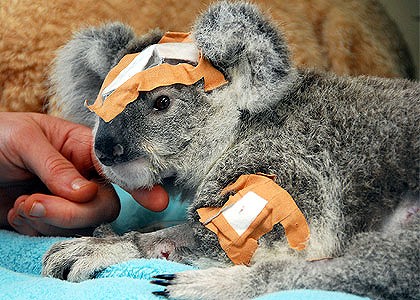 A koala joey, affectionately known as Doug, lies on a pillow after being shot by a slug gun in Morayfield, north of Brisbane, on January 19, 2010.
[Photo source: ^http://www.brisbanetimes.com.au/queensland/baby-koala-clings-on-to-life-20101109-17lsb.html]
A koala joey, affectionately known as Doug, lies on a pillow after being shot by a slug gun in Morayfield, north of Brisbane, on January 19, 2010.
[Photo source: ^http://www.brisbanetimes.com.au/queensland/baby-koala-clings-on-to-life-20101109-17lsb.html]
.
In January 2010, a baby Koala was shot multiple times and eventually died. It’s mother too was shot though survived, as explained in the following news article from Brisbane just two month ago:
‘A young koala is fighting for its life after it was wounded in a cowardly shooting at Morayfield, north of Brisbane.
Moreton Bay Koala Rescue president Annika Lehmann said the young male koala, estimated to be about eight or nine months old, had been taken to Australia Zoo for treatment.
The 940-gram koala, which had been named “Doug”, was in an induced coma.
He was found at the base of a tree at J Dobson Rd in Morayfield, Ms Lehmann said.
“Our rescuers got a call this morning about a little joey sitting at the trunk of a tree and his breathing was laboured,” she said. “Mum was 30 metres up in the tree, so we needed tree climbers to get her down, but the little boy was sitting at the bottom of the tree, so he was easy to get.”
Ms Lehmann said it was unclear how long Doug had been suffering as a result of the attack.
“He was very lethargic and dehydrated, so we don’t think this happened this morning or yesterday, it might have happened one or two days ago,” she said.
“At first we thought he had pneumonia, but when he had an x-ray they discovered the two bullets. “One is in the left chest cavity and one is in the lower abdomen.”
Ms Lehmann said Doug’s mother, which could also have been wounded, was also being assessed.
“I can’t really say much about her condition, but it looks like she’s OK,” she said.
Ms Lehmann said she had never seen a koala shot in the area before, although she was aware of several kangaroos shootings.
“Morayfield is one of those areas that we feel koalas are still relatively safe, so it was really bad that we found him there,” she said.
RSPCA spokesman Michael Beatty said the attack was disturbing, with the joey a “50/50 chance” of survival.
“At first glance, because it was a slug gun that was used, it’s probably kids but we really need to catch those who are responsible,” he said.
“All too often we’ve seen in the past the links between animal cruelty and other forms of violence down the track, so if this was kids they need to be made to be accountable for their actions now to nip something like this in the bud.”
Mr Beatty said people could call Crime Stoppers on 1800 333 000 or the RSPCA Cruelty Complaints Hotline on 1300 852 188 if they had any information on the attack.’
.
[Source: ‘Koalas shot north of Brisbane’, by Cameron Atfield, Brisbane Times, 20100119, ^http://www.brisbanetimes.com.au/queensland/koalas-shot-north-of-brisbane-20100119-mi9s.html]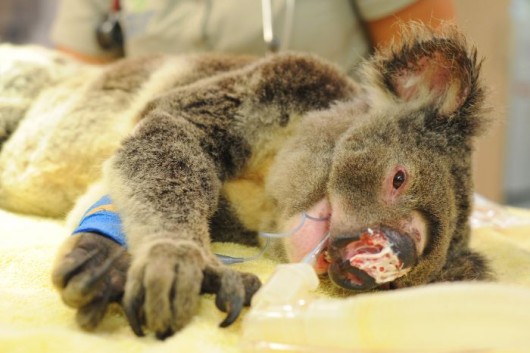 Another Koala shot at Kippa-Ring, north of Brisbane in October 2011
http://www.abc.net.au/news/2011-10-14/vets-to-operate-on-critically-injured-koala/3571394
Another Koala shot at Kippa-Ring, north of Brisbane in October 2011
http://www.abc.net.au/news/2011-10-14/vets-to-operate-on-critically-injured-koala/3571394
.
2009: Kangaroos shot with arrows in Melbourne
.
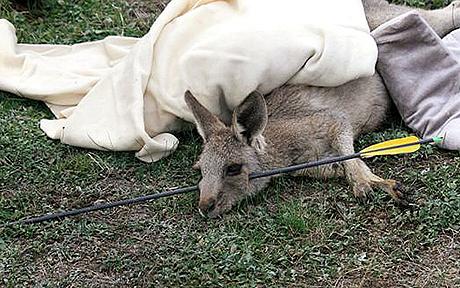 One of the kangaroos shot with an arrow in Melbourne, February 2009
[Photo: Melbourne Zoo]
One of the kangaroos shot with an arrow in Melbourne, February 2009
[Photo: Melbourne Zoo]
.
A man has been arrested over the shooting of two kangaroos with arrows in Melbourne’s outer north this month.
The 27-year-old man from Thomastown, a Northern Melbourne suburb, was arrested in Epping on Wednesday morning. Police say they raided two Thomastown properties and seized two bows, six arrows, an arrow quiver and camouflage clothing. The man is also being interviewed over another incident in which a person was allegedly shooting a bow and arrows in a Bundoora park close to other people.
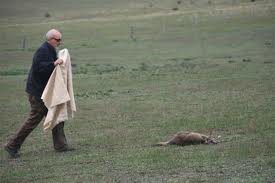 Kangaroo left for dead with an arrow through its head
– it survived
Kangaroo left for dead with an arrow through its head
– it survived
.
An eastern grey kangaroo was found shot in the head with an arrow that had penetrated through the bone and into the nasal cavity at the University Hill Estate in Bundoora on May 9.
After an operation its prospects of a full recovery are good.
In an incident two days earlier at the same location, a juvenile female kangaroo was found with an arrow imbedded in its rump. Wildlife Victoria has offered a $10,000 reward to catch the person responsible.
[Source: ‘Police arrest man over kangaroo arrow shooting’, 20090520, AAP, ^http://www.smh.com.au/environment/conservation/police-arrest-man-over-kangaroo-arrow-shooting-20090520-bew9.html].
Police charged the 27-year-old Thomastown man over the Bundoora shootings that horrified animal lovers this month.
One kangaroo survived after an arrow passed through its head while the other was found with an arrow in its rump. The man was arrested at his workplace on McDonalds Rd, Epping, on Wednesday morning and faces cruelty charges. A search of his house discovered two bows, five arrows, an arrow quiver, a paper target and camouflage clothing.
As he left Mill Park police station, he claimed he “didn’t know they were a protected animal” before driving away in a hotted-up car.
Detective Sen-Constable Dave Richards said police had acted on a tip-off.
“We had received a call from someone concerned for their (kangaroos’) well-being,” he said.
Sen-Constable Richards said police had received several tip-offs, particularly after Wildlife Victoria posted a $10,000 reward for information leading to a prosecution under the Cruelty Act.
The man was charged with reckless conduct endangering life and four counts of aggravated cruelty. He was bailed to appear at Heidelberg Magistrates’ Court on June 25.
Wildlife carer Belinda Gales, who has been looking after the injured kangaroos at Chum Creek Wildlife Shelter, said she was relieved to hear of the arrest.
She said it was a miracle the kangaroos – dubbed Beau and Hope – survived.
“Beau has made an amazing recovery. The only evidence is some small sutures on the side of his head,” Ms Gales said.
“Hope has taken a bit longer, because her wound got infected, but, hopefully, they will both be fine.”
Ms Gales hopes the kangaroos will be released in about two weeks.
“They have come to depend on each other, so they will stay here, and when they are both fit, they will be released together,” she said.
“We don’t know where they will go yet, but the main thing is that they go into a safe environment.”
[Source: Man charged over arrow attack on roos’, by Megan McNaught, Herald Sun, 20090521, ^http://www.heraldsun.com.au/news/more-news/i-didnt-know-they-were-protected/story-e6frf7kx-1225713801707].
Another five months later Twenty-seven-year-old Justin Stavropoulos was found guilty and jailed..
.
‘A man who pleaded guilty in Melbourne to shooting four kangaroos with a bow and arrow has been jailed for 12 months.
Twenty-seven-year-old Justin Stavropoulos pleaded guilty to animal cruelty and hunting protected wildlife. His lawyer asked the court to consider a sentence Stavropoulos could serve in the community.
But Magistrate Jennifer Grubissa said a jail term was the only appropriate sentence to deter other people from doing the same thing. She said the offending was cruel and callous.
The four kangaroos were shot in Bundoora earlier this year.
One survived the attacks. Two died quickly. And a third kangaroo, with an arrow through its face, died after surgery.
The magistrate said Stavropoulos should have known that unless he was a perfect marksman his actions were unlikely to lead to a humane death for the animals.
Stavropoulos was ordered to serve a non-parole period of four months.
Stavropoulos is appealing the sentence. He was granted bail to face an appeal hearing in the County Court next March.
[Source: ‘Man jailed over kangaroo arrow shootings’, by Emma O’Sullivan, ABC, 20091022, ^http://www.abc.net.au/news/2009-10-22/man-jailed-over-kangaroo-arrow-shootings/1113326].
Well, Robin Hood aspirant Stavropoulos appealed the court’s decision, however the judge upheld the jail term..
.
‘A judge has upheld a 12-month jail term given to a camouflage-clad man who shot and maimed kangaroos with a high-powered bow and arrow.
Justin Stavropoulos, 27, killed and maimed several kangaroos during hunting trips in Melbourne’s northern fringe during April and May last year. He was given a 12-month jail sentence, with a minimum of four months, in the Heidelberg Magistrates Court last October, but was bailed pending an appeal.
However, his sentence was today upheld by Victorian County Court judge Frank Gucciardo. Judge Gucciardo said Stavropoulos may not have appreciated the stupidity of his actions, but the community needed to be sent a strong message that violence towards animals was unacceptable. The judge accepted Stavropoulos believed the animals were game and could be hunted, but said it must have been obvious to him that using a high-powered bow and arrow would have caused the animals agony.
“How such a weapon can be so easily obtained can only engender dismay”, he said.
Stavropoulos must pay compensation of more than $4000 to wildlife authorities involved in rescuing the injured animals. Stavropoulos, of Thomastown, had pleaded guilty to charges of animal cruelty and hunting protected wildlife.
Outside court, animal activists welcomed the sentence.
.[Source: ‘Camo-clad roo shooter’s jail term upheld‘, 20100312, AAP, ^http://www.theage.com.au/victoria/camoclad-roo-shooters-jail-term-upheld-20100312-q3nv.html]
.
.
The story made the Los Angeles Times ^http://latimesblogs.latimes.com/unleashed/2009/05/kangaroo-recovering-after-being-shot-through-the-head-with-an-arrow.html
.
2012: Kangaroos shot with arrows in outside Canberra
.
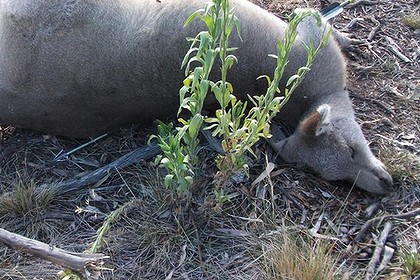 Canberra kangaroos shot with bow and arrows at Mount Ainslie outside Canberra
Canberra kangaroos shot with bow and arrows at Mount Ainslie outside Canberra
.
Kangaroos have been shot and killed with a bow and arrows in what park rangers are describing as a “distressing” spate of attacks on Mount Ainslie.
Two kangaroos were shot dead by arrows in the area in the past two weeks, and one had to be put down to end its suffering.
National Parks, Reserves and Rural Land manager Stephen Hughes said those responsible for the attacks could be charged a range of offences, which could see them face two years in prison and up to $22,000 of fines.
“It is very distressing to discover this illegal behaviour which, in addition to the suffering caused to the kangaroos, poses a public safety hazard,” he said.
“Mount Ainslie is a high use reserve which is particularly popular with late afternoon and evening walkers, joggers and cyclists.”
Police and park rangers have stepped up their monitoring of the area to try and catch the culprits.
Anyone with information is urged to contact Crime Stoppers on 1800 333 000 or make a report via the website at www.act.crimestoppers.com.au.
[Source: ‘Roos attacked with bow and arrow’, 20120207, ^http://www.canberratimes.com.au/act-news/roos-attacked-with-bow-and-arrow-20120207-1t91v.html].
The ACT Government is appealing to the public for information on the arrow attacks. There has been a number of attacks on kangaroos in Canberra’s Mount Ainslie Reserve using a bow and arrow.
Over the past two weeks members of the public have reported finding kangaroos that have been killed or injured with arrows. Rangers found one kangaroo already dead while another had to be put down to end its suffering.
ACT Parks manager Stephen Hughes says the use of a high powered bow and arrow is illegal and the incidents are extremely concerning.
“This is a professional bow and arrow that’s being used,” he said. “Our two major concerns are that apart from the obvious suffering caused to the kangaroos from this activity, it’s a serious threat to the many visitors that walk and ride in Mt Ainslie Nature Reserve every day.
“These people are being put at risk by this irresponsible behaviour.” Mr Hughes says the situation is distressing. “It’s unbelievable that people can find it entertaining to undertake this sort of activity in this day and age, shooting our native wildlife,” he said.
The ACT Government is appealing to the public to help catch the people responsible.
“ACT Policing has been notified of the illegal activity. Together with rangers, police will step up their monitoring of the area,” Mr Hughes said.
[Source: ‘Ainslie roos killed by arrows’, 20120208, ^http://www.abc.net.au/news/2012-02-08/ainslie-kangaroos-shot-arrows/3817500] .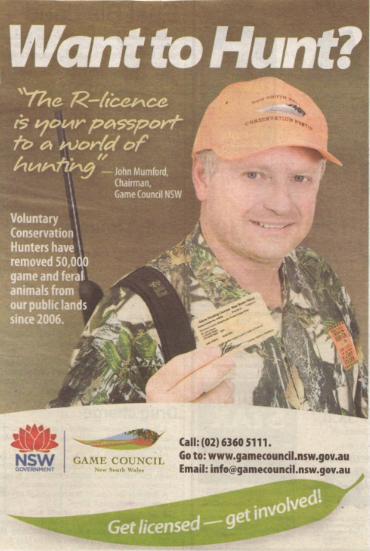 Hobby Killers (killing for fun) continues to be funded by the New South Wales taxpayer
The Game Council NSW uses euphemistic terms like ‘hunt‘ instead of ‘kill‘, and ‘game‘ instead of ‘wildlife‘.
It is a deliberate strategy to demonise wildlife and to seek public legitimacy to kill for fun.
All types of characters are attracted.
Hobby Killers (killing for fun) continues to be funded by the New South Wales taxpayer
The Game Council NSW uses euphemistic terms like ‘hunt‘ instead of ‘kill‘, and ‘game‘ instead of ‘wildlife‘.
It is a deliberate strategy to demonise wildlife and to seek public legitimacy to kill for fun.
All types of characters are attracted.
.
‘Animal Cruelty as a Predictor of Other Criminal Behaviours: Australian Data’
.
‘Research shows abusers believe abuse is justified‘
.
A criminal psychology research article by Robert Agnew of Emory University, USA, entitled: ‘The Causes of Animal Abuse: A Social-Psychological Analysis‘ presents a theory that explains why individuals engage in animal abuse.
“First, I describe the immediate determinants of animal abuse. Animal abuse is said to result from ignorance about the abusive consequences of our behavior for animals, the belief that abuse is justified, and the perception that abuse is personally beneficial.
Second, I describe an additional set of factors that have both direct effects on animal abuse and indirect effects through the above three factors. These additional factors include individual traits, like empathy; the individual’s socialization; the individual’s level of strain or stress; the individual’s level of social control; the nature of the animal under consideration; and the individual’s social position.”
Animal abuse is no different to child abuse.
As disgusted as nearly all Australians are with animal abuse, Australia’s animal protection laws remain are inadequate both as a deterrent and as a punishment.
Wildlife killing and abuse is morally unacceptable and should be made a crime in the same way that killing or abusing humans is a crime. All that would be required is adding an animal section to the existing crimes acts around the country.
“A correlation between animal abuse, family violence and other forms of community violence has been established. Child and animal protection professionals have recognized this link, noting that abuse of both children and animals is connected in a self-perpetuating cycle of violence. When animals in a home are abused or neglected, it is a warning sign that others in the household may not be safe. In addition, children who witness animal abuse are at a greater risk of becoming abusers themselves.” [American Humane Society]
Police are not required to enforce animal cruelty breaches.
Instead it is relegated to an under-resourced, under-equipped RSPCA, which is at best a toothless force. Australia should set a moral standard, establish a national squad within the Australian Federal Police to deal specifically with animal abuse. Australia needs to set up a central database on animal killers and abusers just as in the same way paedophiles are monitored as social deviants. No more abuse!
.
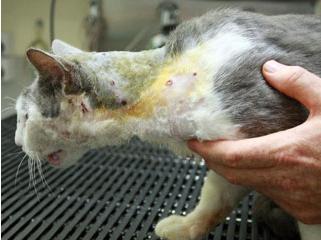 Cat shot 27 times point blank by an air rifle in Cairns
^http://www.cairns.com.au/article/2009/03/02/31331_local-news.html
Cat shot 27 times point blank by an air rifle in Cairns
^http://www.cairns.com.au/article/2009/03/02/31331_local-news.html
.
After the cat incident in Cairns, it seems logical that air rifles and bb-guns are those weapons that adolescents get access to before firearms.
Access and acceptance to such weapons tends to one more familiar with those on the land or a non-urban lifestyle. It may be worth investigating this in an article. Meanwhile, the ‘bevan’ mindset and animal cruelty that persists in some communities is an eye opener.
Check the correspondence in the following sites:
http://www.skylinesaustralia.com/forums/Air-Rifle-t215353.html
http://www.airgunbbs.com/forums/showthread.php?t=119277
http://www.ssaa.org.au/juniors.html
http://www.juniorshooters.com.au/main/Home.htm
http://en.wikipedia.org/wiki/BB_gun
.
Dodgy Story : ‘Man-mauling wombat felled by axe’
.
“…Bruce Kringle, 60, lay on top of the animal in a desperate bid to stop the attack in Flowerdale (Victoria) just before 7am. A neighbour heard his cries for help and, after telling Mr Kringle to move off the animal, killed it with a blow from the back of an axe. Geoff McClure, compliance team leader for the Department of Sustainability and Environment, said a wombat attack was extremely unusual.”
.
Frankly, I find this hard to believe and indeed suspicious. A ‘rogue wombat’? This is a wombat..
 Australian Wombat – a docile noctural herbivore
Australian Wombat – a docile noctural herbivore
.
Wombats are native to this part of Victoria. If anything, it is the humans with axes that are the rogues. Did Kringle have a Alexander Pearcian moment after getting on the turps perhaps? Alexander Pearce was that notorious 19th Century convict in Van Diemans Land who butchered his fellow escapees with an axe then ate them, as the recent disturbing film portrays [Watch Trailer]. (To play video press the arrow in centre of video; to stop video press the pause button on bottom left)
The incident should be investigated by both a RSPCA vet and the police taking account of witnesses, and including a blood alchohol test on both the men, and a background check on Kringle and the ‘neighbour’ who killed it with an axe for any history of animal abuse.
Killing a wombat with an axe? How cruel, vicious and unnecessary!
.
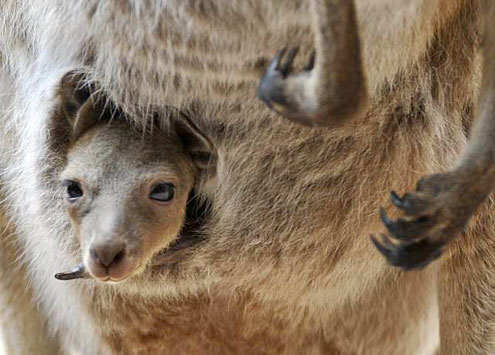 Kangaroo shooting ‘industry’
Kangaroo shooting ‘industry’
.
‘Contrary to claims by regulatory agencies, the industry here in Australia is not fully professional, with a large proportion of casual shooters amongst licensees.
Kangaroos that are inaccurately targeted (not hit in the head from 80 to 200 metres at night) may suffer a painful, protracted death and their carcasses will not be utilised.
Pouch-young joeys are clubbed on the head!
.
Young-at-foot are supposed to be shot, but since the industry is self-regulated, they are often left to die of starvation or predation.
Taken together, it is likely that up to a million young are killed annually as collateral damage and their carcasses not used. This is an unacceptable practice by international standards. They are the by-products of the greatest massacre of wild animals in the world. In a similar case of harvested terrestrial wildlife, the products derived from young Canadian Harp Seals – which are clubbed to death – have been banned in most westernised countries.
[Source: ^http://outbackcooking.blogspot.com.au/2012/03/kangaroo-shooting.html].
“It’s embarrassing for Australia that we eat our own wildlife ….I’m here to tell you it’s just not right. Simply do not buy, use or eat kangaroo products”
~ Steve Irwin (1962 – 2006)
